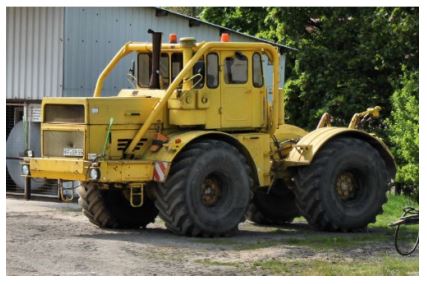First Amendment Protects Videogame’s Depiction of Tractor’s Trade Dress–Saber v. Oovee
This case involves the Polish tractor manufacturer Kirovets’ K-700 tractor:
Saber makes the videogame MudRunner. It exclusively licensed the right to depict the K-700 in its videogames, including the right to enforce the exclusive license in court. Oovee make the videogame Spintires. The court says: “Users interact with the virtual world by selecting a vehicle (which is like a character) and by navigating the virtual environment.” Spintires added a depiction of the K-700 as a playable vehicle. Saber sued Oovee for Lanham Act false designation of origin and related state claims.
Note the unusual posture of this lawsuit: the plaintiff is a videogame manufacturer suing another videogame manufacturer for violating the rights of a third-party trademark owner, creating the possibility that any adverse precedent would hurt both parties long-term. I hope Saber is playing a smart game of 4D chess, because as an outsider it looks like an attempted own-goal. Both parties should be working to facilitate the free and unlicensed depictions of third-party elements in their games, not reifying existing property rights schemes.
First Amendment Defense to Lanham Act Claim
The court applies the Rogers v. Grimaldi test, consistent with the (uncited) AM General v. Activision case (Humvee v. Call of Duty).
Expressive work: Videogames are expressive works. It helps to have a Supreme Court case (Brown) standing for that proposition.
Artistic relevance: Saber “does not explain how Oovee’s use of the K-700 is artistically irrelevant.”
Explicitly misleading: Saber argued that videogame players expect that game manufacturers have licensed any actual vehicles depicted in the simulation (boo). The court says that’s not enough to show that Oovee explicitly misled consumers.
Saber also attacks this disclaimer in Spintires:
All other trademarks are the property of their respective owners. All characters and vehicles appearing in Spintires ® are fictitious (except where licensed). Any representations to real-life persons (living or dead), or real-world vehicle designs (except where licensed), is purely coincidental.
The court says “the disclaimer is far from a model of clarity.” It’s certainly not a disclaimer I would have advised.
Saber claims the disclaimer represents that either a depicted vehicle is either fictitious or licensed. The court tendentiously reads the disclaimer to say that it indicates that the K-700 wasn’t licensed because Oovee never disclosed the license, unlike a different vehicle where it did license and disclose. This raises the obvious question of why Oovee licensed some vehicle depictions and not others (I assume Saber’s exclusive license had something to do with that). The court’s reading also necessarily implies that Oovee’s depiction of the K-700 was either “fictitious” or “purely coincidental,” neither of which are true. So this disclaimer put the court in a pickle that it resolves in a less-than-satisfying way. I do agree with the court’s bottom-line that the disclaimer “does not explicitly mislead consumers into believing that Saber or PTZ is affiliated with Spintires.”
Motion to dismiss for Oovee. The court concludes: “Under the Rogers test, Oovee did not impermissibly infringe on Saber’s mark and trade dress. As a result, Oovee was not required to obtain a license.”
Implications
Rogers v. Grimaldi Test. Yay for the Rogers v. Grimaldi test for helping structure/organize First Amendment considerations in Lanham Act cases. But…I always cringe a little when I see the Rogers v. Grimaldi test used outside of its original context of titles for expressive works. Turning Rogers v. Grimaldi into a general-purpose First Amendment defense risks putting more strain on the test than it can handle.
Plus, it’s a bit nerve-wracking to think of Oovee’s depiction as requiring a First Amendment defense, rather than relying on the organic prima facie elements of the claims. I hate seeing cases turn into Constitutional litigation where it can be avoided.
Permission Culture. It’s easy to see how permission culture took root in this corner of the videogame market. Once a game manufacturer pays for an exclusive license, they stop being a potential defendant and turn into a litigious plaintiff seeking to recoup their investments. This then motivates rivals to get their own exclusive licenses, and it’s a race to the (very expensive) bottom. But if everyone could freely proceed without a license, the entire industry will benefit. So Oovee is working towards a public good.
Implications for Videogames and the Metaverse. We’re in the midst of a battle royale over the legally permitted verisimilitude of commercial videogames and immersive environments like virtual worlds and the metaverse. It seems obvious that game designers should be able to depict real-life without running into a rights thicket, which almost certainly would make verisimilitude financially and operationally infeasible. Yet, the rulings in this genre are not all good news. It’s great to see First Amendment limits on trademark claims, but that doesn’t extend to copyright claims–leading to troubling rulings like the Orton case, where one heavily tatted wrestler can single-handedly turn into an insurmountable rights thicket. As we spend more of our lives in these virtual realities, we need clarity ASAP about whether they can accurately depict our physical reality.
Case citation: Saber Interactive Inc. v. Oovee, Ltd, 2:21-cv-01201-JHC (W.D. Wash. Oct. 6, 2022)

